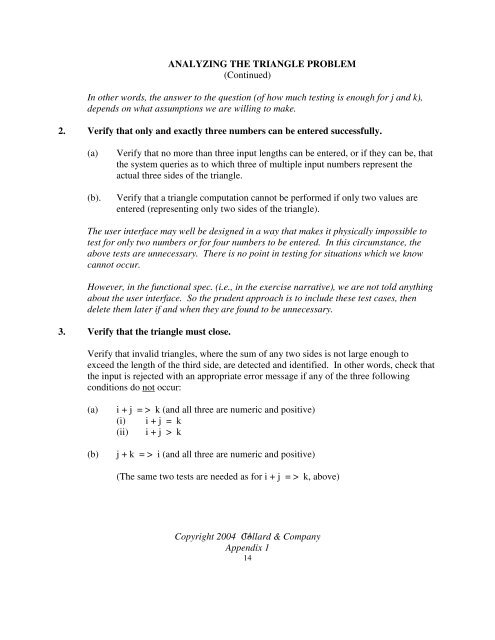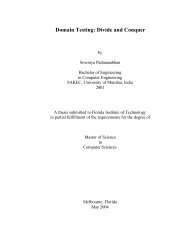appendix 1. analyzing the triangle problem - Testing Education
appendix 1. analyzing the triangle problem - Testing Education
appendix 1. analyzing the triangle problem - Testing Education
Create successful ePaper yourself
Turn your PDF publications into a flip-book with our unique Google optimized e-Paper software.
ANALYZING THE TRIANGLE PROBLEM<br />
(Continued)<br />
In o<strong>the</strong>r words, <strong>the</strong> answer to <strong>the</strong> question (of how much testing is enough for j and k),<br />
depends on what assumptions we are willing to make.<br />
2. Verify that only and exactly three numbers can be entered successfully.<br />
(a) Verify that no more than three input lengths can be entered, or if <strong>the</strong>y can be, that<br />
<strong>the</strong> system queries as to which three of multiple input numbers represent <strong>the</strong><br />
actual three sides of <strong>the</strong> <strong>triangle</strong>.<br />
(b). Verify that a <strong>triangle</strong> computation cannot be performed if only two values are<br />
entered (representing only two sides of <strong>the</strong> <strong>triangle</strong>).<br />
The user interface may well be designed in a way that makes it physically impossible to<br />
test for only two numbers or for four numbers to be entered. In this circumstance, <strong>the</strong><br />
above tests are unnecessary. There is no point in testing for situations which we know<br />
cannot occur.<br />
However, in <strong>the</strong> functional spec. (i.e., in <strong>the</strong> exercise narrative), we are not told anything<br />
about <strong>the</strong> user interface. So <strong>the</strong> prudent approach is to include <strong>the</strong>se test cases, <strong>the</strong>n<br />
delete <strong>the</strong>m later if and when <strong>the</strong>y are found to be unnecessary.<br />
3. Verify that <strong>the</strong> <strong>triangle</strong> must close.<br />
Verify that invalid <strong>triangle</strong>s, where <strong>the</strong> sum of any two sides is not large enough to<br />
exceed <strong>the</strong> length of <strong>the</strong> third side, are detected and identified. In o<strong>the</strong>r words, check that<br />
<strong>the</strong> input is rejected with an appropriate error message if any of <strong>the</strong> three following<br />
conditions do not occur:<br />
(a) i + j = > k (and all three are numeric and positive)<br />
(i) i + j = k<br />
(ii) i + j > k<br />
(b) j + k = > i (and all three are numeric and positive)<br />
(The same two tests are needed as for i + j = > k, above)<br />
Copyright 2004 Collard 14 & Company<br />
Appendix 1<br />
14








